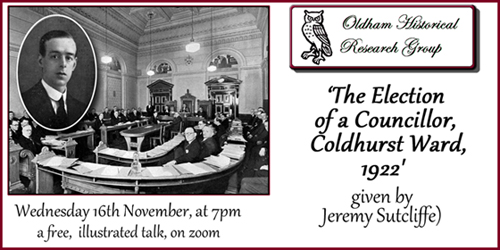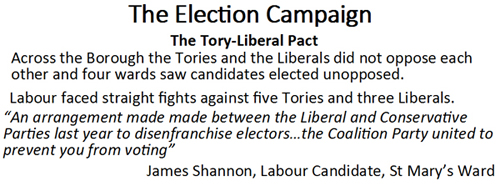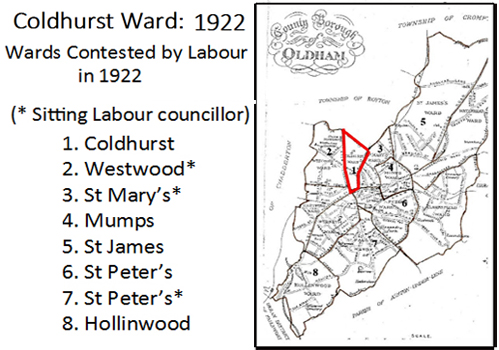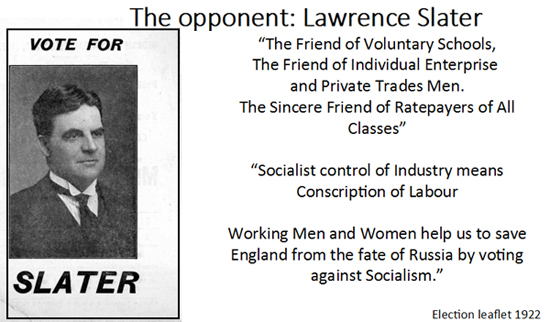
The Election of a Councillor, Coldhurst Ward, 1922'. from an illustrated presentation given by Jeremy Sutcliffe Parts 1 & 2 HERE Part 3 External Squeeze Following the acceptance of the ILP candidacies and the Jagger candidacy in St. Peter's, the number of seats the Trades and Labour Council would now fight stood at eight, the same as the previous year. True to the pact also signed in 1921, the Conservatives and Liberals did not oppose each other and their candidates in the four wards not contested by Labour were returned unopposed. In the contested wards, Labour faced five Conservatives (described as Unionists by the Conservative oriented Oldham Standard) and three Liberals.
Some Labour electoral material did seek to exploit the negative aspects of the Conservative/Liberal anti Labour pact. Frith and Shannon, in a flyer for Shannon in St Mary's, describe it as "an arrangement made between the Liberal and Conservative Parties last year to disenfranchise electors" and continue to describe the Conservatives and Liberals jointly of being "the Coalition Party" who have "united to try and prevent you from voting." In St.Paul's Ward, Slater's election address also addresses this theme. He points out that "if the Labour Party had not put forward candidates you would not have been able to choose at all and the whole of the people of Oldham would have had no voice in the management of your town's affairs." And that this is "because the Liberal and Conservative leaders have decided not to oppose each other at elections, but to appoint your Councillors by private arrangements amongst themselves." His election address then vigorously and repeatedly attacks the Conservative and Liberal administration of the town as "The Coalition".
While the contest across the whole borough is of interest, that in Coldhurst is particularly so because it is here that there is both an ILP Labour candidate, Frank Tweedale, who has emerged from the Trades Council's internal rumblings to contest an election, and who is also faced by the external squeeze of the Conservative/Liberal pact with only a Conservative opponent. Helpfully Tweedale's election address remains extant, as does other ephemera from the campaign. Of the eight seats contested by the Trades and Labour Council in 1922, Coldhurst was to be the only one to be won. He had been born in Waterhead, near where the Tweedale family had first settled in the Oldham area in 1629, and had been educated first at the local council school and then at an establishment known as "Greenacres Grammar School". He had begun work as a half-timer at the age of ten, first as a check lad at the engineering firm of Asa Lees and later in a cotton mill, where he became a fully-fledged little piecer, before securing an apprenticeship as a fitter at the textile engineering giant, Platts. From the age of thirteen he filled out his education at Derker Night School and later on at Oldham Technical School. His engineering qualifications earned him the "reserved occupation" designation that had exempted him from military service during the Great War. He had joined the ILP at the age of 18 and had become a wholehearted activist. There is a suggestion that he was involved with the Saddleworth ILP and, if so, it is interesting to speculate whether he took part in Victor Grayson's campaign in the by-election in the Colne Valley in 1906 (Saddleworth being part of the then Colne Valley constituency), and even whether it was actually that campaign which had stimulated his involvement. He was equally active in the AEU and was, in 1922, branch president. His initial nomination as a possible Labour candidate, had been made by both the ILP and by two of the AEU's branches. The Coldhurst Ward which the ILP had put him forward to fight was smaller than the current Metropolitan Borough's ward of the same name, this modern ward having been largely formed by amalgamation with the adjacent Westwood Ward following local government re-organisation in 1974. In 1922 Coldhurst's southern boundary was West St, between Rochdale Rd and Henshaw St and these latter roads marked its western and eastern boundaries respectively. It stretched northwards between these roads to the Borough's boundary with Royton on the open upland of Oldham Edge. It was one of the poorest wards in Oldham. Tweedale's daughter recalls visiting houses on West St. that had earth floors. It was one of the earliest parts of Oldham to undergo slum clearance and today if a hundred buildings are standing that were standing in 1922 it is as many. Its densely packed streets are now covered by the Oldham Metropolitan Borough's Civic Centre complex and developments such as the Barker St and Coldhurst Hollow council housing estates. In 1922, it had been contested by Labour only once before. That had been in 1919 in a straight fight against a Tory, when the Labour party had secured only 40% of the vote. Frank Tweedale's election address, typical of many of the era, resembles a four-side greeting card with pages little bigger than the size of a postcard. His photograph is on the front page and there are two and a half sides of closely printed text. There is no direct reference to the ILP. He presents himself as a candidate endorsed by the TLC and as a member of the Labour party and not the ILP. However, in its tone, his text typifies the burgeoning optimism and certainty of the left: – "I come before you as a representative of an organisation that is destined in the next few years to be the ruling power in local and national affairs." It uses a vocabulary characteristic of the class struggle. Unemployment is decribed as "a product of the present social order". Builders' cartels have taken "advantage of the needs of the workers". He points out that sanitation is only dealt with when it does not "interfere with the interests of the property owning Councillors." Voting Labour, he claims, is "a blow for your own class." Two major policy issues are addressed, those of unemployment and housing, together with a reference to the borough's domestic rate level. Tweedale argues that the unemployed are being used as a means of wage reduction for the benefit of those who profit from it – namely the interests of the orthodox and established political parties, the Tories and the Liberals. Oldham Council's poor record in unemployment assistance is referred to and he suggests,"that much more could be done by getting on with many schemes of needed improvement within the town." With regard to housing, he points to the failure of local authorities to exploit their powers for building schemes and to allow private building cartels to drive up the cost of municipal housing to prohibitive rental levels. He calls for "bold policies" allowing councils to do either their own building work or to use Building Guilds, "run by workers" in order to "break the backs of the profiteers." Within the comments on housing, Tweedale also includes public health concerns since "workers are herded together in slum areas living under conditions which make good health impossible." He argues that health should be one of the first duties of local government but points out that it is His final paragraphs state his common identity and solidarity with the electorate of Coldhurst Ward. He might not be a resident and ratepayer in the ward but "like most of you I depend on my labour." He claims to "understand your trials and tribulations," because "when you are doing badly so am I". The Labour campaign in Coldhurst opened with Tweedale's adoption meeting at the Primitive Methodist School on Henshaw St, on Wednesday October 18th. In introducing himself, Tweedale stressed his Trade Union credentials. He argued that if one looked at politics from a trade union point of view there was no doubt who the working man should vote for:- "In a town like Oldham 95% of the people were working class and the problems that came before the Town Council were those affecting the working man". As a consequence he described Oldham Council's treatment of the unemployed as a "crying shame." (Indeed, all Oldham Chronicle reports of Labour adoption meetings held that week indicate that the plight of the local unemployed was a major theme taken up by Labour candidates.) Tweedale was supported at his adoption meeting by Florence Jagger, the St. Peter's candidate. Even though the extant Tweedale material and her own election address does not make an issue of it, her speech this evening reflected a concern about the Conservative-Liberal electoral pact. She accused the Liberals of joining hands with the enemy and objecting to portrayals of Labour, which were ranging from being "a nuisance" to being "a savage monster that was out to devour all it came across. " This antipathy towards Labour from the other two parties clearly emerges from the report of the meeting held in support of the incumbent Coldhurst Conservative councillor, Lawrence Slater, who is described on a surviving election leaflet as "The Friend of Voluntary Schools, The Friend of Individual Enterprise and Private Tradesmen, The Sincere Friend of the Ratepayers of All Classes." The meeting was held under the banner of the "Unionist Labour Party" at the Unionist Club on Barker St., presumably an attempt by the Conservatives to hang on to the hearts and minds of the traditional working class Conservative vote.
A leading Conservative, Alderman Perkins, advised the meeting that the Unionist Labour Party had been formed "To educate workers as to what was best in English political life and in keeping with the rights of Labour." He regarded the British working man as neither revolutionary nor Communistic, unlike the workers elsewhere in Europe. He commended this Unionist Labour Party as being untainted by Socialism or Communism. He concluded by declaring to acclamation. "There is no need for a Communistic, Socialistic or Bolshevik element in a level headed town like Oldham." Much of the meeting was concerned with a debate to support amendments to legislation to deny Trade Unions the ability to use their political levy to support Labour candidates. Cllr. Elisha Bardsley, describing himself as "an old trade unionist" who believed that trade unions only had a future if they stuck to their original industrial and non-political functions, asked the meeting if "anybody would be so bold as to maintain that if the Labour were finding their own money, there would next month be seven political contests in Oldham. " (Jagger's eighth candidature still at that time not declared). He directed his ire particularly at the "political blunderers of the ILP." The vituperativeness of this debate goes a long way to explaining some of the caution of the. TLC with regard to the ILP as many of its delegates and affiliated members must have, like Bardsley, been "old trade unionists ", maintaining a sympathy for non-political trade unionism. The report of the meeting suggests that the issues discussed made little reference to the impending municipal election, except the introduction to the platform of William Tweedale, who was identified as Labour candidate, Frank Tweedale's, younger brother, William Tweedale is then reported to have spoken briefly in support of the issues raised at the meeting. William was affectionately regarded as its black sheep by the rest of the largely socialist Tweedale family. Until his premature death from a misdiagnosed appendicitis in the early 1930s, he was a frequent contributor to the Oldham Standard, writing from a Conservative working class perspective. His appearance at this meeting shows how quick the Conservatives were to try to use him as thorn in his brother's side. Besides the copy of Frank Tweedale's election address, there remains little direct evidence of the activity of the election campaign - the canvassing, the street corner meetings, besides a pair of supplementary leaflets, one from each side – but overall, during the campaign, Labour was to benefit from Slater's illness that prevented him from being fully active. The two supplementary leaflets are apparently a complementary pair, dealing largely with the issue of recent changes in domestic ratable values compared with industrial ones. Although it is impossible to say which one was issued first, Slater's leaflet seems to read as a response to the one from Tweedale. On its front, the two sided Tweedale leaflet displays detailed figures to point out that the Liberal and Conservative re-rating exercise had resulted in an 8 shilling per annum rise for householders, while factories had experienced a £600 reduction. The text on the reverse argues that the net result of the changes meant that domestic ratepayers were contributing 15 shillings and sixpence for a net benefit to factories and workshops of £450. The final slogan echoes the end of Tweedale's election address by urging a vote for "the Labour candidate who understands your needs." Slater's single-sided leaflet seeks to justify the changes in ratable value by referring to accumulated changes since 1914 which have seen mill rate assessments rise by 63% while domestic assessments had risen by 40% and lodges the claim that if it had not been for increases in mill rates in the past, the domestic rate would be higher. The leaflet concludes with a strong anti-socialist fervour echoing Perkins fear of Bolshevism which had been expressed at Slater's public meeting:- "Socialist control of industry only means conscription of Labour, Working Men and Women help us to save England from the fate of Russia by Voting against Socialism." The election day saw a 57 % turnout in Coldhurst Ward. High for a local election by today's standards, this was actually the sixth highest turnout of the eight wards contested in Oldham that year, with St. Mary's topping 70%. The Coldhurst result was a narrow 44 vote victory for Tweedale by 1060 to 1016. It was Labour's only victory of the night. The Conservatives put their defeat down to apathy and Lawrence Slater's illness, Only in Hollinwood was there any other encouragement for Labour, where Kenyon missed out by only 92 votes, although it was to be six more years before Labour actually won the seat. In St.Paul's, St.Mary's, and Westwood, the wards won by Labour in the previous year, the defeat was, in each case, by over a thousand votes. They were in fact the biggest defeats of the night. In St.Mary's the swing against Labour since the previous year was 13%, and against Shannon, since he had contested it as a Liberal in 1919, was 15%. In Hollinwood, St.James' and Mumps, where the margin of defeat was less, Labour members could react ruefully on the pact that had denied them the seat, while the anti-Labour vote could congratulate itself on its success. However within days the anti-Labour parties would be crying foul when Labour won its first parliamentary seat in Oldham in the 1922 General Election, by campaigning for its supporters to vote for the one candidate only in the two member division. Although the Oldham Standard carries a lengthy account of the Conservative's post election celebrations neither local paper carries any report of Labour's post election gathering at the Oddfellows' Hall but one Oldham Labour veteran, the late Alderman Ellen Brierley recalls her mother returning from it saying that, despite everything a "little lion" had been elected. In 1922, despite the antipathy of the TLC to the ILP and of the Conservatives and Liberals jointly to Labour, he had won through to make a significant contribution to his borough. It was to be a contribution developed and continued, first by his nephew Arnold Tweedale OBE who became the borough's Labour Agent in the late thirties and who served on the County Borough Council, and later the Metropolitan Borough Council, from 1938 until his death in 1988 and later by his grandson, Jeremy Michael Tweedale Sutcliffe, who served on the County Borough from 1971 to 1974 and on the Metropolitan Borough Council from 1995 until 2008 contributed by Jeremy Sutcliffe |
Return to Members' Own Menu





